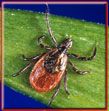
Your Subtitle text
Anaplasmosis
Anaplasmosis is a tickborne disease caused by the bacterium Anaplasma phagocytophilum. It was previously known as human granulocytic ehrlichiosis (HGE) and has more recently been called human granulocytic anaplasmosis (HGA). Anaplasmosis is transmitted to humans by tick bites primarily from the black legged tick (Ixodes Scapularis) and the western black legged tick Ixodes pacificus). Of the four distinct phases in the tick life-cycle (egg, larvae, nymph, adult), nymphal and adult ticks are most frequently associated with transmission of anaplasmosis to humans. Typical symptoms include: fever, headache, chills, and muscle aches. Usually, these symptoms occur within 1-2 weeks of a tick bite. Anaplasmosis is initially diagnosed based on symptoms and clinical presentation, and later confirmed by the use of specialized laboratory tests. The first line treatment for adults and children of all ages is doxycycline. Anaplasmosis and other tickborne diseases can be prevented.

